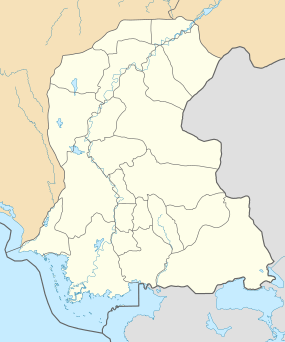Hala, Sindh
| Hala Hala New | |
|---|---|
| City | |
 Hala | |
| Coordinates: 25°49′N 68°26′E / 25.81°N 68.43°ECoordinates: 25°49′N 68°26′E / 25.81°N 68.43°E | |
| Country |
|
| Province | Sindh |
| Elevation | 39 m (128 ft) |
| Population (2000) | |
| • Total | 161,980 |
| Time zone | PST (UTC+5) |
Hala (Sindhi: هـالا) is a city and taluka of Matiari district of Sindh, Pakistan. According to the Revenue record, Hala was given the status of Taluka in 1848.
Sufism
Hala became a leading centre of the Suhrawardi sect of Sufism from the 16th century onwards. It contains the mausoleum of Makhdum Nuh (died circa 1592), a Suhrawardi Pir,[1] which attracts pilgrims.
Culture
Hala has a rich Sindhi culture. Men clad themselves in a traditional Shalwar Kameez having broader bottoms and traditional Sindhi cap, previously in Hala, common wear for women was Gharara or 'Parro' with bangles all the way up till shoulders but nowadays this type of wear is in countryside not on the city of Hala. Presently women at their homes wear Shalwar Kamiz with a Dupatta over their heads and out in town they prefer to wear Burqas in public. Clogging road-side tea-stalls with colleagues and friends, is a favorite pastime for Halai men.
Hala Bazaar
The Hala baazar is a famous bazaar where people from many cities go for shopping.Hala is also famous for its handicraft like Ajrak, Soosi, Khadi, Jhandi and Kashi.
References
- ↑ Ansari, Sarah F. D. (1992). Sufi Saints and State Power: The Pirs of Sind, 1843-1947. Cambridge South Asian Studies. 50. Cambridge University Press. pp. 20, 31. ISBN 9780521405300.